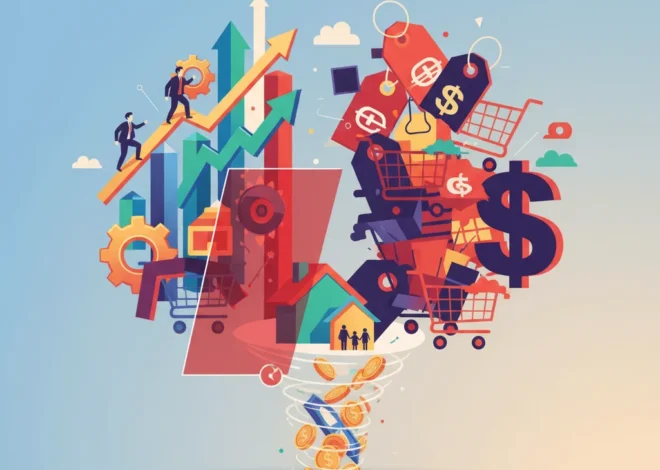
Wall Street’s Warning Bell: Is the US Financial System’s Plumbing About to Clog Again?
The Silent Engine of the Economy is Sputtering. Here’s Why It Matters.
Deep within the intricate machinery of the global economy lies a critical, yet often overlooked, component: the US money market. Think of it as the financial system’s plumbing—the vast network of pipes and valves that allows cash to flow seamlessly between banks, corporations, and the government on an overnight basis. When it works, it’s invisible. When it clogs, the entire structure is at risk. Today, some of the most prominent engineers of that system—Wall Street’s largest banks—are sounding the alarm. They are warning the Federal Reserve that this essential plumbing is showing signs of strain, risking a repeat of the sudden market seizure that shocked the world in 2019.
The core of their concern, as highlighted in a recent report, is that a confluence of government policy and central bank strategy could drain too much cash from the banking system. This could cause short-term borrowing rates to spike unexpectedly, creating a liquidity crunch with far-reaching consequences for the broader economy, the stock market, and every investor’s portfolio. To understand this risk, we need to look at the powerful forces at play and why the Fed finds itself walking a precarious tightrope between fighting inflation and maintaining financial stability.
The Two-Pronged Squeeze on Bank Liquidity
The current pressure on the money markets isn’t the result of a single event but rather the combined effect of two major government actions. Understanding these is key to grasping the challenge facing the financial system.
1. The Treasury’s Unprecedented Debt Issuance
To fund its operations, the U.S. government sells Treasury bills, notes, and bonds. Following the resolution of the debt ceiling debate, the Treasury has been issuing a massive volume of new debt. When investors, money market funds, and corporations buy these securities, they pay for them with cash that is then transferred from commercial bank accounts to the government’s account at the Federal Reserve. This action effectively pulls liquidity, or bank reserves, out of the private banking system. While a normal and necessary function, the sheer scale of the current issuance is acting like a powerful siphon on the system’s cash reserves.
2. The Federal Reserve’s Quantitative Tightening (QT)
Simultaneously, the Fed is actively engaged in its own campaign to remove liquidity from the system. Known as Quantitative Tightening (QT), this policy is the reverse of the Quantitative Easing (QE) that was used to support the economy for years. Under QT, the Fed allows its massive portfolio of government bonds to mature without reinvesting the proceeds. This also reduces the level of reserves in the banking system. The goal of QT is to tighten financial conditions to help bring inflation under control. However, when combined with the Treasury’s actions, it creates a powerful one-two punch that drains cash at an accelerated rate.
This dynamic is creating a slow but steady decline in the reserves that banks hold at the Fed. These reserves are the lifeblood of the financial system, used to settle payments between banks and serve as the ultimate buffer against unexpected funding needs. When these reserves become scarce, the cost of borrowing them overnight—the primary activity in the money markets—can become volatile and unpredictable.
A Frightening Echo of September 2019
For those in the world of finance and economics, this scenario sounds eerily familiar. In September 2019, the financial plumbing did, in fact, clog. A similar combination of factors—large Treasury settlements and a drawdown of reserves from QT—caused a sudden and severe cash shortage. Overnight borrowing rates in the “repo” market, a crucial segment of the money market where banks lend to each other against collateral, skyrocketed from around 2% to as high as 10% (source). This was a five-alarm fire for the Federal Reserve, which was forced to intervene with emergency cash injections for the first time since the 2008 financial crisis to restore order.
The 2019 event revealed that the Fed had misjudged the minimum level of reserves the banking system needed to operate smoothly. Now, Wall Street is warning that we may be approaching that critical threshold once again. The fear is that another unexpected spike in short-term rates could not only disrupt funding markets but also trigger forced selling in other asset classes, creating a vicious cycle of instability that could quickly spill over into the stock market and corporate credit markets.
The Fed’s Toolkit: Options and Complications
The Federal Reserve is not powerless, but each of its options comes with trade-offs. The debate among policymakers and market participants revolves around which tool to use and, critically, when to use it.
Below is a breakdown of the primary tools at the Fed’s disposal to manage a potential liquidity squeeze.
| Tool | How It Works | Potential Benefit | Potential Drawback |
|---|---|---|---|
| Standing Repo Facility (SRF) | Allows eligible banks to borrow cash from the Fed overnight at a set rate, using Treasuries as collateral. | Acts as a ceiling for short-term rates, providing an immediate backstop against extreme spikes. | “Stigma” may prevent banks from using it preemptively, limiting its effectiveness as a preventative measure. |
| Slow or End QT | The Fed reduces the pace at which it lets bonds mature, or stops the process altogether. | Stops the active draining of reserves from the system, stabilizing the level of liquidity. | Could be seen as a dovish pivot, potentially complicating the fight against inflation and sending a mixed signal to markets. |
| Restart Asset Purchases (“QE”) | The Fed begins buying government bonds again, actively injecting new reserves into the banking system. | The most powerful tool to quickly increase liquidity and calm stressed markets. | Directly contradicts the anti-inflationary stance, potentially damaging the Fed’s credibility and fueling inflation concerns. |
According to major banks like JPMorgan Chase, the Fed may need to be prepared to halt QT and potentially even restart asset purchases if a significant stress event occurs (source). This highlights the severity of the risk they perceive. The challenge for the Fed is to act before a crisis erupts without prematurely abandoning its fight against inflation.
The Future Is Tradable: How Crypto ETPs Are Making Bitcoin and Ethereum Investing Simple and Secure
Why This Back-Office Problem Affects Your Front-Office Portfolio
It’s easy to dismiss money market mechanics as a technical issue for bankers and economists. However, the health of this system has direct and significant implications for every participant in the economy.
- For Investors: A spike in overnight lending rates can create immense volatility. Financial institutions facing higher funding costs may be forced to sell other assets, including stocks and bonds, to raise cash. This can trigger a broad market sell-off. Uncertainty in the bedrock of the financial system undermines investor confidence, leading to a “risk-off” sentiment that hurts equity valuations.
- For Business Leaders: The rates set in the money markets serve as a benchmark for many other forms of short-term business and consumer lending. If the system becomes stressed, the cost of commercial paper, supply chain financing, and other essential corporate funding tools can rise, squeezing profit margins and potentially delaying investment.
- For the Broader Economy: A dysfunctional funding market is like a clot in the economy’s circulatory system. It slows the flow of credit, making it harder for businesses to expand and for consumers to borrow. If left unchecked, a severe liquidity crisis can easily tip a fragile economy into recession.
The Path Forward: Watching the Gauges
The warnings from Wall Street serve as a crucial, proactive signal. Unlike 2019, the market and the Fed are now acutely aware of the risks. The key question is where the new “floor” for ample reserves lies. Some analysts believe the system can withstand a further drain, while others argue we are already in the danger zone. Central bankers will be meticulously monitoring key indicators like the Secured Overnight Financing Rate (SOFR) and the usage of its lending facilities for any signs of funding pressure.
The Billion-Pound Blunder: When Green Investments Create a Financial Nightmare
Ultimately, this is a story about balance. The Federal Reserve must balance its mandate for price stability with its role as the guardian of financial stability. By tightening its belt to fight inflation, it risks choking off the liquidity that the system needs to breathe. The coming months will be a critical test of the Fed’s ability to navigate this complex environment, and the outcome will have a profound impact on the trajectory of investing, trading, and the global economy for the foreseeable future.


